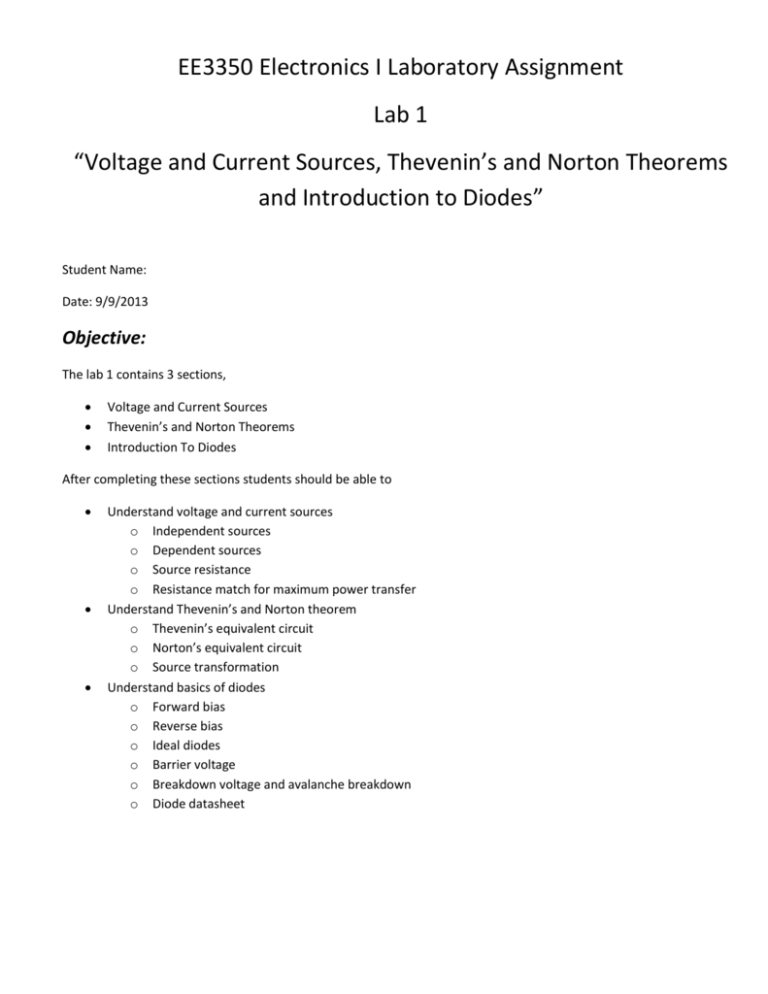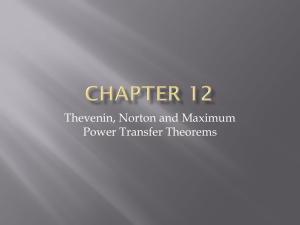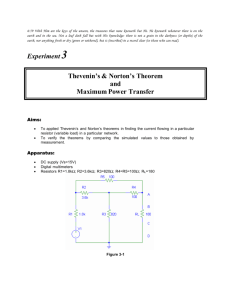Lab 1 (.doc) - aslanistan.com
advertisement

EE3350 Electronics I Laboratory Assignment Lab 1 “Voltage and Current Sources, Thevenin’s and Norton Theorems and Introduction to Diodes” Student Name: Date: 9/9/2013 Objective: The lab 1 contains 3 sections, Voltage and Current Sources Thevenin’s and Norton Theorems Introduction To Diodes After completing these sections students should be able to Understand voltage and current sources o Independent sources o Dependent sources o Source resistance o Resistance match for maximum power transfer Understand Thevenin’s and Norton theorem o Thevenin’s equivalent circuit o Norton’s equivalent circuit o Source transformation Understand basics of diodes o Forward bias o Reverse bias o Ideal diodes o Barrier voltage o Breakdown voltage and avalanche breakdown o Diode datasheet PART I -) Voltage and Current Sources a. Constant voltage and current sources. Please construct the circuit shown in figure 1a and 1b using Multisim. Rs 50 V1 10 V I1 1A RL Figure 1a. Constant voltage source with 50Ω source resistance Rs 1M RL Figure 1b. Constant current source with 1MΩ source resistance Complete the tables below using Multisim and draw load vs. load resistance graphs (Stiff region). Table 1.a Load voltage measurements for Figure 1.a RL (Ohms) VRL Table 1.b Load current measurements for Figure 1.a RL (Ohms) 0 0 50 1,000 100 10,000 1000 100,000 5000 1,000,000 50000 10,000,000 IRL VRL RL Figure 2. Graph using table 1a. Show the stiff region. IRL RL Figure 3. Graph using table 1b. Show the stiff region. b. Voltage Controlled Voltage Source (VCVS). Please construct the circuit shown in figure 1a and 1b using Multisim. R2 1k R3 1k V1 10 V V2 2 V/V Figure 4. Voltage controlled voltage source. What is the multiplier (k)? Write V2 in terms of VR3. Complete the table below using Multisim. Table 2. Voltage measurements for Figure 4 R3 (kΩ) 1 2 3 4 5 VR3 VR1 R1 1k PART II -) Thevenin’s and Norton’s Theorems a. Thevenin’s Theorem. Please construct the circuit shown in figure 5. I2 R3 V3 R1 1k 1k R2 1k 10 V 1mA R10 1k R5 2k R4 4k R8 3k V2 10 V V1 10 V I1 20mA R7 R6 2k R9 1k 3k I3 1mA R11 R13 3k 1k R12 4k RL Figure 5. Circuit with variable RL Measure the Thevenin’s equivalent of the circuit in Figure 5. Using the circuit determine the RL for maximum power transfer. Rth Vth RL Figure 6. Thevenin’s equivalent of the circuit in figure 5. After measure the values of Rth and Vth please put the circuits in figure 5 and in figure 6 side by side in Multisim and complete the table below. Table 3. Thevenin’s Theorem verification RL (kΩ) VRL (Figure 5) VRL (Figure 5) 1 1.7 2.2 4.7 5.2 6.7 b. Norton’s Theorem. Using the figure 5 using Multisim. Measure Rn and In using Multisim and complete the Norton’s equivalent of the circuit below. In Rn RL Figure 7. Norton’s equivalent of the circuit in figure 5. c. Source Transformation. Using the Figure 6 and source transformation calculate the In and Rn. Compare your result with Figure 7. In Rn Figure 7. Norton’s equivalent of the circuit in figure 5. RL PART III -) Basic Diode Circuit a. Forward Bias. Please construct the circuit shown in figure 8. D2 1N4148 R1 V1 1k Figure 8. Forward Biased Diode Complete the table 4 below using Multisim and draw the ID vs V1 graph. Table 4. Load voltage measurements for Figure 8. V1 (Volts) ID (mA) 0 0.2 0.5 0.7 1.5 2.5 7 12 ID V1 Figure 9. Graph using table 4. b. Reverse Bias. Please construct the circuit shown in figure10. D2 1N4148 R1 V1 1k Figure 10. Reverse Biased Diode Complete the table 5 below using Multisim and draw the ID vs V1 graph. Table 5. Load voltage measurements for Figure 10 V1 (Volts) ID (mA) 0 10 20 40 60 100 200 400 V1 ID Figure 11. Graph using table5.








